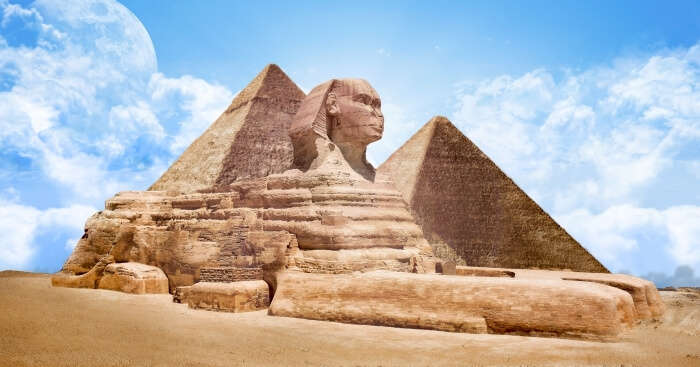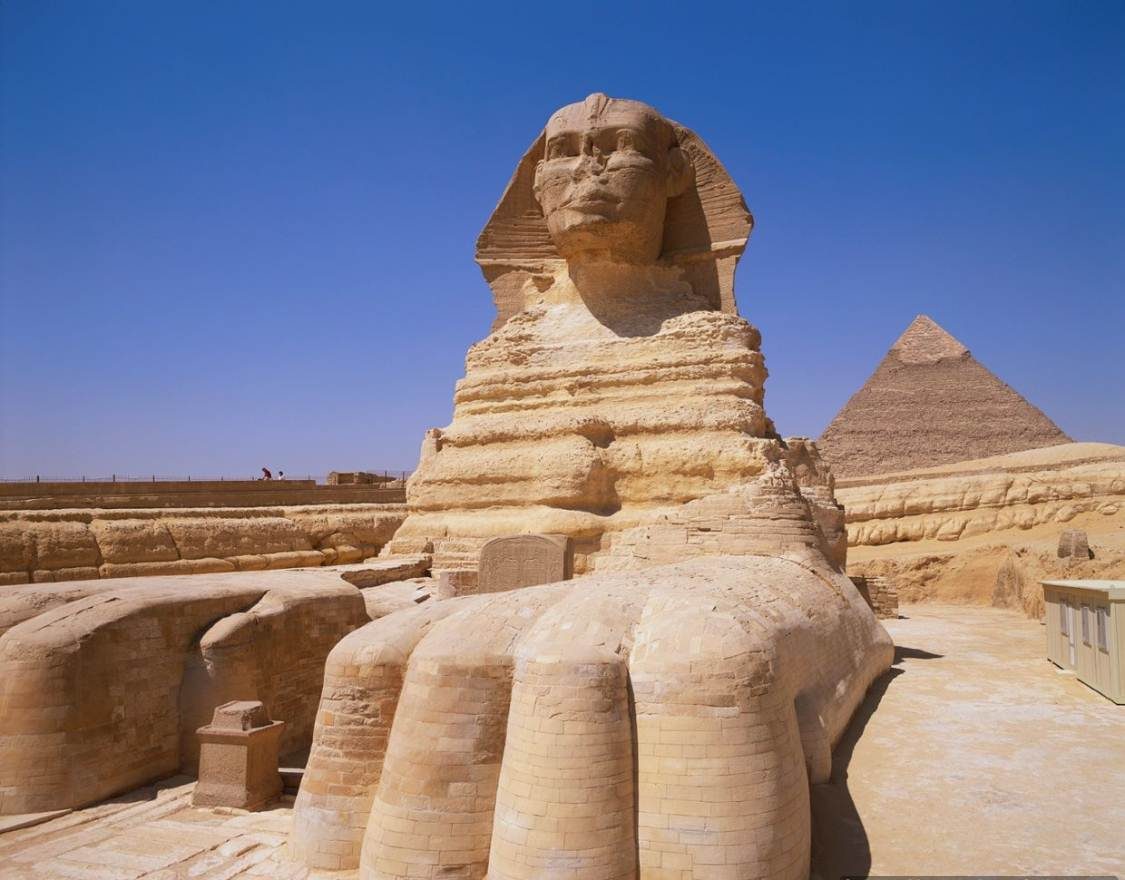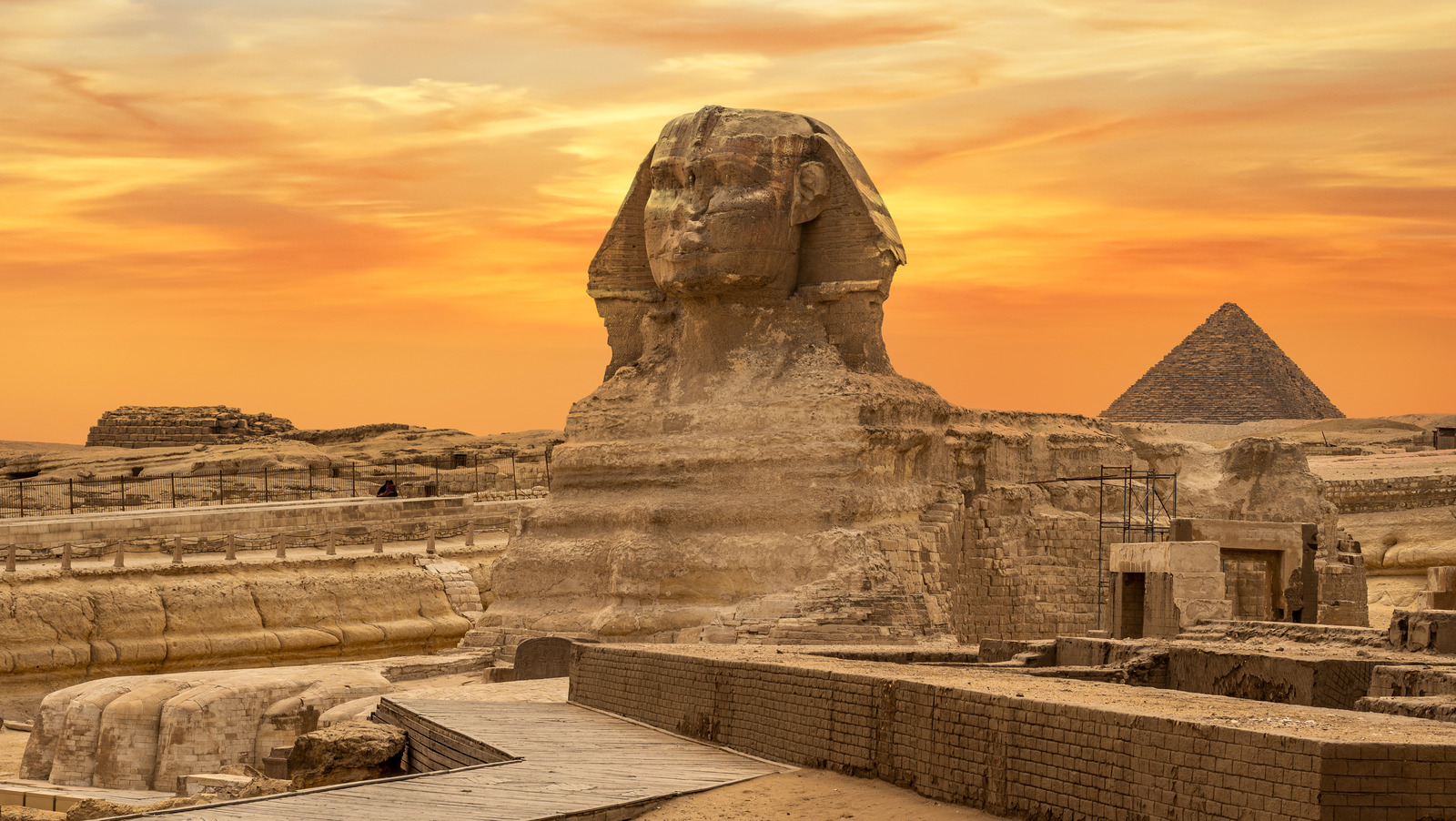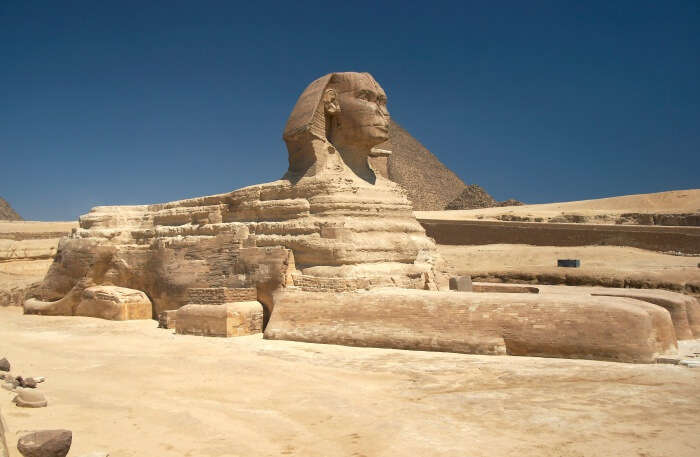The Great Sphinx of Giza: A Mysterious Monument with a Rich History
May 24
The Great Sphinx of Giza is one of the most famous landmarks in the world, serving as a symbol of Egypt and ancient civilizations. This colossal statue of a mythical creature with a lion's body and a human's head is breathtaking in its scale and grandeur. Not only is the Sphinx a remarkable piece of artistry, but its history is shrouded in mystery and intrigue, leaving many questions unanswered and inspiring countless theories and legends. In this blog post, we will delve into the fascinating story of the Great Sphinx of Giza and explore the many mysteries surrounding this incredible monument.

Description and Location of the Sphinx
Welcome! If you're planning a trip to Egypt, one of the most famous landmarks you'll want to see is the Great Sphinx of Giza. Here is a guide on everything you need to know about the Sphinx.
The Great Sphinx of Giza is a giant limestone statue with a lion's body and a human's head. Standing 240 feet (73 meters) long and 66 feet (20 meters) high, it's one of the biggest monuments in the world. It's located near the Great Pyramid in Giza, Egypt, and is one of the most recognizable relics of the ancient Egyptians.
History:
The history of the Sphinx is still being debated, but it's believed to have been built during the reign of Pharaoh Khafre around 2600 BC. The Sphinx is thought to have been constructed to protect the Pharaoh's tomb and complex. Some scholars believe there may have been a divine purpose to the Sphinx and temple complex to resurrect the soul of the Pharaoh by channelling the power of the sun and other gods.
Location:
The Great Sphinx is located near the Great Pyramid in Giza, Egypt. To get to the Sphinx, you'll need to head to the Giza Plateau, which is about 11 miles away from Cairo. You can easily get to the Giza Plateau by taxiing, bus, or hiring a tour guide. Once you arrive at the Giza Plateau, you'll see the Sphinx and the Great Pyramids in one panoramic view. You can also take a guided tour to learn more about the Sphinx and its history.
Tips:
1. Wear comfortable shoes as there will be much walking and standing.
2. Bring sun protection as it can get very hot and sunny.
3. Respect the site and don't litter or damage the Sphinx.
4. Hiring a tour guide can be very helpful if you want to learn more about the Sphinx and its history.
5. Be prepared to be approached by vendors selling souvenirs and tours. Be firm but polite when declining them if you're not interested.
The Great Sphinx of Giza is a must-see landmark for anyone visiting Egypt. With its impressive size and fascinating history, it's no wonder why it's one of the most famous landmarks in the world. Follow this guide to learn more about the Sphinx and how to get there. [1][2]
The Great Sphinx of Giza is a giant limestone statue with a lion's body and a human's head. Standing 240 feet (73 meters) long and 66 feet (20 meters) high, it's one of the biggest monuments in the world. It's located near the Great Pyramid in Giza, Egypt, and is one of the most recognizable relics of the ancient Egyptians.
History:
The history of the Sphinx is still being debated, but it's believed to have been built during the reign of Pharaoh Khafre around 2600 BC. The Sphinx is thought to have been constructed to protect the Pharaoh's tomb and complex. Some scholars believe there may have been a divine purpose to the Sphinx and temple complex to resurrect the soul of the Pharaoh by channelling the power of the sun and other gods.
Location:
The Great Sphinx is located near the Great Pyramid in Giza, Egypt. To get to the Sphinx, you'll need to head to the Giza Plateau, which is about 11 miles away from Cairo. You can easily get to the Giza Plateau by taxiing, bus, or hiring a tour guide. Once you arrive at the Giza Plateau, you'll see the Sphinx and the Great Pyramids in one panoramic view. You can also take a guided tour to learn more about the Sphinx and its history.
Tips:
1. Wear comfortable shoes as there will be much walking and standing.
2. Bring sun protection as it can get very hot and sunny.
3. Respect the site and don't litter or damage the Sphinx.
4. Hiring a tour guide can be very helpful if you want to learn more about the Sphinx and its history.
5. Be prepared to be approached by vendors selling souvenirs and tours. Be firm but polite when declining them if you're not interested.
The Great Sphinx of Giza is a must-see landmark for anyone visiting Egypt. With its impressive size and fascinating history, it's no wonder why it's one of the most famous landmarks in the world. Follow this guide to learn more about the Sphinx and how to get there. [1][2]

Original Shape and Restoration
Have you ever wondered about the original shape of the Great Sphinx of Giza and its restoration? The Sphinx is a statue of a reclining lion with a human head located on the west bank of the Nile River in Egypt. The original shape of the Sphinx was cut from the bedrock and has since been restored with layers of limestone. It measures 240 ft long from paw to tail, 66 ft high from the base to the top of the head, and 62 ft wide at its rear haunches. It is uncertain why the Sphinx’s nose was broken off, but it is confirmed that it happened sometime between the 3rd and 10th centuries. Contrary to popular myth, Napoleon's army did not break it during the Battle of the Pyramids.
The Great Sphinx is the oldest known statue in Egypt, created by ancient Egyptians during the reign of Khafre, who specifically referred to it as the Terrifying One. The face of the Sphinx appears to represent Khafre himself. Still, the original name the creators gave the Sphinx is unknown as the Sphinx temple enclosure and possibly the Sphinx itself was not completed then, and thus cultural material was limited. The stones cut from around the Sphinx's body were used to construct a temple in front of it. Still, neither the enclosure nor the temple was ever completed, and the relative scarcity of Old Kingdom cultural material suggests that a Sphinx cult was not established then.
Various efforts have been undertaken to preserve the Great Sphinx since it has greatly deteriorated. The body has suffered the most, but the face has also been damaged; notably, the nose is missing. According to some, the damage was caused by Napoleon's troops who shot off the nose with a cannon, but illustrations that date before Napoleon reveal a noseless Sphinx. Another theory suggests that a Sufi Muslim extremist Mohamed Sam al-Dahr broke the nose in 1378 and was later executed for vandalism, but it is unlikely.
Today, the Great Sphinx of Giza is one of the most recognizable statues in the world and is a popular tourist attraction. Visitors can explore the Sphinx temple enclosure and marvel at the engineering feats achieved by ancient Egyptians. From the Sphinx's original shape and restoration to its cultural significance and various theories about its history, the Great Sphinx has captivated people's imaginations for centuries. [3][4]
The Great Sphinx is the oldest known statue in Egypt, created by ancient Egyptians during the reign of Khafre, who specifically referred to it as the Terrifying One. The face of the Sphinx appears to represent Khafre himself. Still, the original name the creators gave the Sphinx is unknown as the Sphinx temple enclosure and possibly the Sphinx itself was not completed then, and thus cultural material was limited. The stones cut from around the Sphinx's body were used to construct a temple in front of it. Still, neither the enclosure nor the temple was ever completed, and the relative scarcity of Old Kingdom cultural material suggests that a Sphinx cult was not established then.
Various efforts have been undertaken to preserve the Great Sphinx since it has greatly deteriorated. The body has suffered the most, but the face has also been damaged; notably, the nose is missing. According to some, the damage was caused by Napoleon's troops who shot off the nose with a cannon, but illustrations that date before Napoleon reveal a noseless Sphinx. Another theory suggests that a Sufi Muslim extremist Mohamed Sam al-Dahr broke the nose in 1378 and was later executed for vandalism, but it is unlikely.
Today, the Great Sphinx of Giza is one of the most recognizable statues in the world and is a popular tourist attraction. Visitors can explore the Sphinx temple enclosure and marvel at the engineering feats achieved by ancient Egyptians. From the Sphinx's original shape and restoration to its cultural significance and various theories about its history, the Great Sphinx has captivated people's imaginations for centuries. [3][4]

Size and Dimensions
When you stand before the Great Sphinx of Giza, it's hard not to be overwhelmed by its size and dimensions. The statue itself measures a staggering 240 feet (73 meters) long from paw to tail, 66 feet (20 meters) high from the base to the top of the head, and 62 feet (19 meters) wide at its rear haunches. That's roughly equivalent to the length of two football fields!
But even more impressive is that the Great Sphinx was carved from a single piece of limestone. Creating such a massive sculpture would have been incredibly challenging, requiring a team of approximately 100 workers wielding stone hammers and copper chisels for an estimated three years.
Despite its enormous size, the Great Sphinx is quite delicate. Over the centuries, the statue has suffered considerable damage, particularly to its face and nose. While it's uncertain why the Sphinx's nose was broken, several theories exist. Some believe that Napoleon's troops shot off the nose with a cannon, while others suggest that it was damaged by weather and erosion over time. Interestingly, paintings and records dating back to the 17th century depict the Sphinx without a nose, suggesting that it had been missing for centuries before Napoleon's invasion.
In addition to its impressive size and delicate features, the Great Sphinx symbolises ancient Egyptian culture and history. The statue is widely believed to have been created during the reign of King Khafre (2558-2532 BCE) to depict his face. However, some speculate that the Sphinx was built by Khafre's older brother, Djedefre, in honour of their father, King Khufu, known for building the Great Pyramid of Giza.
Regardless of its origins, the Great Sphinx remains one of the world's most recognizable and awe-inspiring monuments. Its sheer size, exquisite craftsmanship, and rich history make it a must-see destination for anyone interested in ancient Egypt and its fascinating culture.
So if you find yourself standing before the Great Sphinx of Giza, take a moment to appreciate its incredible size and dimensions, and consider the incredible craftsmanship and skill that went into creating this iconic statue. [5][6]
But even more impressive is that the Great Sphinx was carved from a single piece of limestone. Creating such a massive sculpture would have been incredibly challenging, requiring a team of approximately 100 workers wielding stone hammers and copper chisels for an estimated three years.
Despite its enormous size, the Great Sphinx is quite delicate. Over the centuries, the statue has suffered considerable damage, particularly to its face and nose. While it's uncertain why the Sphinx's nose was broken, several theories exist. Some believe that Napoleon's troops shot off the nose with a cannon, while others suggest that it was damaged by weather and erosion over time. Interestingly, paintings and records dating back to the 17th century depict the Sphinx without a nose, suggesting that it had been missing for centuries before Napoleon's invasion.
In addition to its impressive size and delicate features, the Great Sphinx symbolises ancient Egyptian culture and history. The statue is widely believed to have been created during the reign of King Khafre (2558-2532 BCE) to depict his face. However, some speculate that the Sphinx was built by Khafre's older brother, Djedefre, in honour of their father, King Khufu, known for building the Great Pyramid of Giza.
Regardless of its origins, the Great Sphinx remains one of the world's most recognizable and awe-inspiring monuments. Its sheer size, exquisite craftsmanship, and rich history make it a must-see destination for anyone interested in ancient Egypt and its fascinating culture.
So if you find yourself standing before the Great Sphinx of Giza, take a moment to appreciate its incredible size and dimensions, and consider the incredible craftsmanship and skill that went into creating this iconic statue. [5][6]

Broken Nose Myth and Archaeological Evidence
Have you ever heard the myth that Napoleon Bonaparte was responsible for breaking the nose of the Great Sphinx of Giza? Despite its popularity, this myth has been refuted by several sources, including 15th-century Arab historian al-Maqrīzī and a painting by Danish Naval Captain and explorer Frederic Louis Norden in which the Sphinx is depicted without a nose. It is believed that the nose of the Sphinx was intentionally broken, but not by Bonaparte. An archaeological study performed by Mark Lehner suggests that the nose was intentionally broken sometime between the 3rd and 10th centuries. Although it remains uncertain why the nose was broken, erosion from natural disasters such as wind, rain, and earthquakes is a likely cause. The Great Sphinx remains one of the most recognizable statues in the world, carved from the bedrock of the plateau, which also served as the foundation for the pyramids and other monuments in the area. It was created around 2500 BC by the pharaoh Khafre, and its original name remains unknown. While the Sphinx has been given several names from various cultures and countries throughout history, its enduring mystique and significance continue to captivate the imaginations of people around the world, 4500 years after it was built. [7][8]

Oldest Known Statue in Egypt
Are you curious about the oldest known statue in Egypt? Look no further than the Great Sphinx of Giza! This incredible monument is distinguished by a lion's body and a human's head adorned with royal headdresses. It is carved from a single piece of limestone, which is believed to have taken around three years to complete using stone hammers and copper chisels, worked on by some 100 workers. With a length of 20 meters and a width of 73 meters, it is one of the largest statues in the world.
While historians believe that the Great Sphinx belongs to the Fourth ruling dynasty and was added to by Khafre, some believe that it was built by Khafre’s older brother, Djedefre, to commemorate their father, Khufu. This ruler built the Great Pyramid at Giza. Despite the debate on ownership, most agree that the Great Sphinx is one of Egypt’s most iconic landmarks. Its face, however, bears the marks of time and has greatly deteriorated over the centuries. Various efforts have been undertaken to preserve it since ancient times, possibly beginning in the reign of Tuthmosis IV (1400–1390 BC), who placed a stele between its front paws.
Interestingly, the nose of the Great Sphinx is notably missing, though it is unclear how this happened. One theory suggests that it was damaged by Napoleon’s troops when they shot it with a cannon, while illustrations that date before Napoleon reveal a noseless sphinx. Some even suggest that Muhammad Saʾim al-Dahr, a Sufi Muslim, mutilated the statue in the 14th century to protest against idolatry.
Regardless of its missing features, the Great Sphinx remains an incredible testament to the ancient Egyptians' artistry, craftsmanship, and ingenuity. It is part of the larger complex of the Great Pyramids of Giza, featuring three huge tombs: the Great Pyramid of Khufu, Khufu’s son Khafre, and the Pyramid of Menkaure. These pyramids were built as tombs to protect the pharaohs’ bodies and to store or protect the supplies they would need in the afterlife from thieves.
Visitors today flock to the Great Sphinx of Giza to marvel at its size and history, and it is sure to remain a fixture of Egypt’s rich cultural heritage for generations to come. [9][10]
While historians believe that the Great Sphinx belongs to the Fourth ruling dynasty and was added to by Khafre, some believe that it was built by Khafre’s older brother, Djedefre, to commemorate their father, Khufu. This ruler built the Great Pyramid at Giza. Despite the debate on ownership, most agree that the Great Sphinx is one of Egypt’s most iconic landmarks. Its face, however, bears the marks of time and has greatly deteriorated over the centuries. Various efforts have been undertaken to preserve it since ancient times, possibly beginning in the reign of Tuthmosis IV (1400–1390 BC), who placed a stele between its front paws.
Interestingly, the nose of the Great Sphinx is notably missing, though it is unclear how this happened. One theory suggests that it was damaged by Napoleon’s troops when they shot it with a cannon, while illustrations that date before Napoleon reveal a noseless sphinx. Some even suggest that Muhammad Saʾim al-Dahr, a Sufi Muslim, mutilated the statue in the 14th century to protest against idolatry.
Regardless of its missing features, the Great Sphinx remains an incredible testament to the ancient Egyptians' artistry, craftsmanship, and ingenuity. It is part of the larger complex of the Great Pyramids of Giza, featuring three huge tombs: the Great Pyramid of Khufu, Khufu’s son Khafre, and the Pyramid of Menkaure. These pyramids were built as tombs to protect the pharaohs’ bodies and to store or protect the supplies they would need in the afterlife from thieves.
Visitors today flock to the Great Sphinx of Giza to marvel at its size and history, and it is sure to remain a fixture of Egypt’s rich cultural heritage for generations to come. [9][10]
